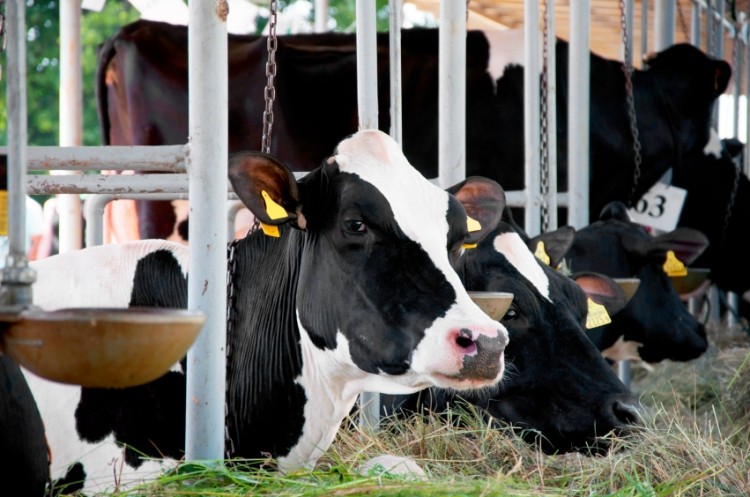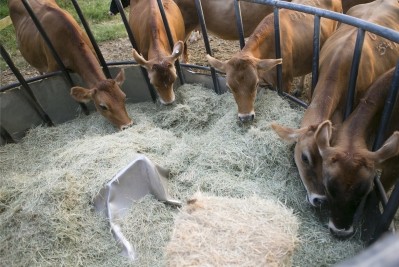Scientists look to reduce grain portion of dairy cow diets

A team of Austrian researchers experimented with alternative feed inputs to remove components that could be used in food in an effort to improve the sustainability of dairy production and reduce criticism of the industry.
“The aim of this study was therefore to investigate the effects of a complete substitution of common cereal grains and pulses with a mixture of wheat bran and sugar beet pulp in a high-forage diet on cow performance, production efficiency, feed intake, and ruminating behavior, as well as on net food production potential,” said the researchers.
The scientists concluded the alternative ingredients were able to support milk production levels.
“Our data suggest that in forage-based dairy production systems, wheat bran and sugar beet pulp could replace common cereal grains in mid-lactation dairy cows without impairing performance, while strongly increasing human-edible feed conversion efficiency and net food production index,” said the researchers in the study.
Sustainable replacements
Increasing global population is expected to put pressure on both animal production and the need to reduce the use of human-edible feeds in livestock production, said the researchers.
“In the trade-off between feeding for high animal performance and reducing human-edible inputs at the same time, fiber-rich by-products offer promising opportunities, especially in terms of energy supply (Bradford, 1999; Gill, 2013),” they said.
In fact, the authors noted fiber-rich by-products have long been used in dairy cattle nutrition, both as alternative feedstuffs to forage, or as alternative fiber [nonforage fiber sources (NFFS)] and energy sources for high-yielding dairy cattle (Swain and Armentano, 1994; Bradford and Mullins, 2012; Dann et al., 2014).
However, data on NFFS usage in high-forage diets, as well as quantitative data on the potential of NFFS to increase NFP and human-edible feed conversion efficiency (heFCE), are limited, they said.
The heFCE expresses the human-edible output through the animal product per human-edible input in feedstuffs. In an earlier feeding trial, the researchers substituted a mixture of industrial by-products for a mixture of commonly used concentrates as energy and protein sources and found that this substitution could increase the human-edible feed conversion efficiency by 4 and 2.7 times for energy and protein, respectively, without impairing milk production (Ertl et al., 2015b).
"However, the by-products included in this earlier trial were still rich in NEL and CP (to achieve an isoenergetic and isonitrogenous experimental diet), which is most likely not true for the majority of common by-products that are available in large quantities," they added.
With an annual production of nearly 3m tons of sugar beets and close to 1.5m tons of wheat, these were two of the top five commodities produced in Austria in 2013, reported the authors. "With an annual production of nearly 250m tons of sugar beets and over 600m ton of wheat worldwide, these commodities are also among the most commonly cultivated crops around the world (FAO, 2015)," added teh team.
The researchers said during processing of sugar beets and wheat, about 20% of the dry matter (DM) results in the by-products sugar beet pulp and wheat bran, respectively, which indicates their high availability (Fadel, 1999). They reported that while several studies have evaluated the inclusion of sugar beet pulp in dairy cow diets (Bhattacharya and Lubbadah, 1971; Hemingway et al., 1986; Voelker and Allen, 2003), less is known about the use of wheat bran.
“We hypothesized that replacing the grain concentrate portion in a high-forage diet (75% of total DMI) with wheat bran and sugar beet pulp would not impair milk performance data, DMI, or chewing activity in low-performing dairy cows, but we expected strong effects on NFP [net food production] and efficiency indicators,” said the researchers.
The study
In the experiment, 13 multiparous and seven primiparous cows in mid-lactation were given one of one of two diets in a change-over design feeding experiment that ran seven weeks.
“Cows were fed a high-forage diet (grass silage and hay accounted for 75% of the dry matter intake [DMI]), supplemented with either a cereal grain-based concentrate mixture (CON), or a mixture of wheat bran and dried sugar beet pulp (WBBP),” they said. “Human-edible inputs were calculated for two different scenarios based on minimum and maximum potential recovery rates of human-edible energy and protein from the respective feedstuffs.”
Cows spent two weeks adapting to the diet and measurements were taken during weeks 3 to 7, said the researchers. At the end of the first trial period, cows were switched to the other diet.
“Dietary treatments were not formulated to be isoenergetic or isonitrogenous, but to obtain the same forage-to-concentrate ratio of 0.75:0.25 on a DM basis,” they said. The control diet included forage and a commonly used commercial concentrate supplement, while the experimental diet had forage, minerals, vitamins and the wheat bran and dried sugar beet pulp additive, they added.
Milk yield amount and chewing patterns were recorded and feed intake was calculated along with DMI and body weight, they said. Milk samples were checked for fat, protein, lactose and milk urea concentrations.
“Human-edible feed conversion efficiencies were calculated for two different scenarios [minimum (min) and maximum (max)] on a CP [crude protein] and gross energy basis, respectively, and were defined as daily human-edible output per daily human-edible input (Wilkinson, 2011),” said the researchers.
Results
Fiber content was larger in the experimental diet, said the researchers, but it was lower in starch. Total DMI and DMI as a percentage of body weight were the same for both treatments.
Milk yield and composition were the same for both diets, they said. Feed conversion efficiency and nitrogen use also were similar between the treatments.
“Despite higher NDF intakes, no effects of the dietary treatment on eating and ruminating activity in minutes per day, as well as per kilogram of DMI, were observed,” they said. Cows getting the experimental diet had reduced chewing activity per kilogram of neutral detergent fiber (NDF), they added.
“Compared with CON, the heFCE in WBBP for the max scenario was 6.8 and 5.3 times higher for energy and protein, respectively,” said the researchers. However, human-edible inputs in the WBBP group could not be calculated for the min scenario as it involved dividing by zero, they added.
Overall, the use of the alternative ingredients increased heFCE and NFP in cows when compared to use of a grain-based concentrate, they said.
Source: Journal of Dairy Science
Title: Feeding of wheat bran and sugar beet pulp as sole supplements in high-forage diets emphasizes the potential of dairy cattle for human food supply
DOI: doi:10.3168/jds.2015-10285
Authors: P. Ertl, Q. Zebeli, W. Zollitsch, W. Knaus










